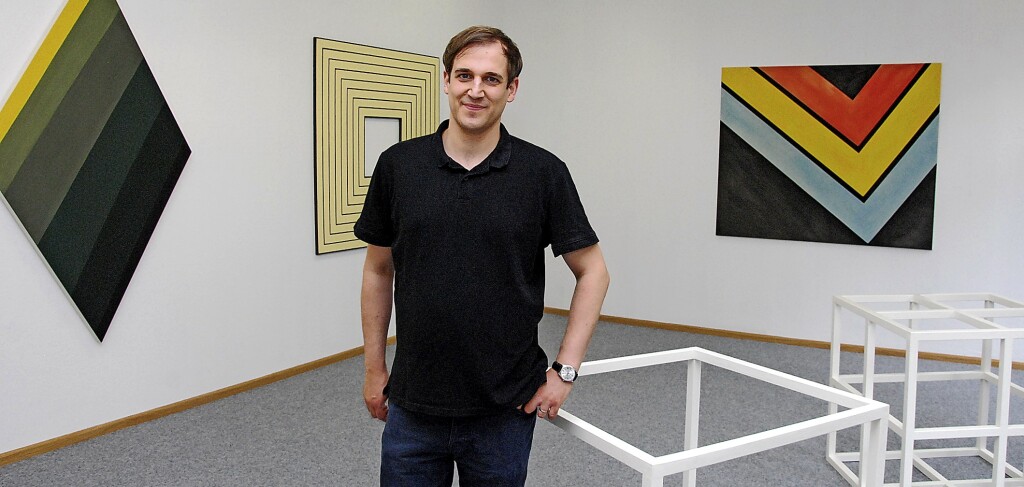The new exhibition at the Kunstforum in Waldkirch displays the work of Frank Altman.
. Until Sunday, August 29, the work of artist Frank Altmann, who lives in Rottweil, can be viewed at Georg-Scholz-Haus-Kunstforum under the title “Abstract021”.
Each of Altman’s work is an examination of another’s work, and of course this only becomes clear when you look at the accompanying catalog, because in the gallery you only see the finished product. His business should work without the template. Altman picks a detail, often a geometric pattern, from a work of art history and shows this section enlarged. The details can be very small in the original image, but they don’t have to be. The sources of his image come from different times and cultures, often pre-modern: Japanese masters of the eighteenth and nineteenth centuries. century, Goethe’s color theory or the work of the Irish mathematician Oliver Byrne, who for his part dealt with the graphic representations of Euclid.
In his photographs and sculptures, Altman also deals with contemporary artists such as Malevich and Mondrian. The titles of his works are usually the title and year of creation of his original works. For example, an image created in 2015 with acrylic paint on cotton gratingly titled “Ooka Shunboku – Ehon tekagami 1720.”
Altmann was born in Villingen-Schoeningen in 1981. Between 2002 and 2009 he studied in Karlsruhe, Mexico and Stuttgart. “My main place of work is the library,” says Altman. While studying, he noticed that his fellow students had a workshop director, depending on what subject they were working on. “I don’t have anything like that,” he asked. When the librarian said he could take her place on vacation, he realized that the library had this job for him: he had spent a great deal of time rummaging through books to find something that had the potential to become an abstract image as a detail.
In the exhibition, Altman put his works together in groups. In Room 1, you can see pictures of him dealing with constructivism by Malevich, but also replicas of Bayern’s Euclidean representations. In Room 2 there are colorful works and finely drawn drawings based on calligraphy. Room 3 is the “Black and White Room”: a black cube measuring 90 x 90 x 90, the model of which is found by Altmann in a 1647 depiction of Jean Dubereuil, contrasted with a fine graphic depiction consisting only of calligraphy work and Kitagawa Utamaru “a woman reading a letter under a mosquito net” ( 1798) borrowed. In the fourth room, Altman hung his bird boxes, which he calls Experimental Arrangements: “An experimental arrangement to see what sparrows think of modernity.” Mondrian, for example, is the model. The crates are designed to function as bird crates. Altman tried it: birds already nest in it.
The type of cases are hanging in room 6. Altmann uses chests of the type, such as those used in newspaper printing or in a button factory, and fills them with colored synthetic resin. “I’m trying to find a system that can make an image of it,” he explains. Sometimes the type case fills in completely, sometimes only individual fields, so that the result is again reminiscent of Mondrian.
In Room 7 there is a slide projection created without a camera: Frank Altmann cut disposable packages and chips into a 2.4×3.6 format, framed them and displayed them with stunning effect. He calls Room 9 “The American Room” because there are works hanging there in which he reflects portraits of American artist Kenneth Noland with excerpts from pre-modern representations. This could be a trigonometric detail from an 18th century Japanese work, enlarged and rotated so that it is strikingly reminiscent of the many different trigonometric representations of Noland.
As a result, Altman’s portraits look like abstract works by contemporary artists, but he says, “I wouldn’t call myself an abstract artist.”
George Schulz House Art Forum, Schlettstadtallee 9 (Bürgerhaus) Waldkirch, Friday and Saturday, 3 p.m. to 6 p.m., Sunday 11 a.m. to 3 p.m.

Communicator. Reader. Hipster-friendly introvert. General zombie specialist. Tv trailblazer

